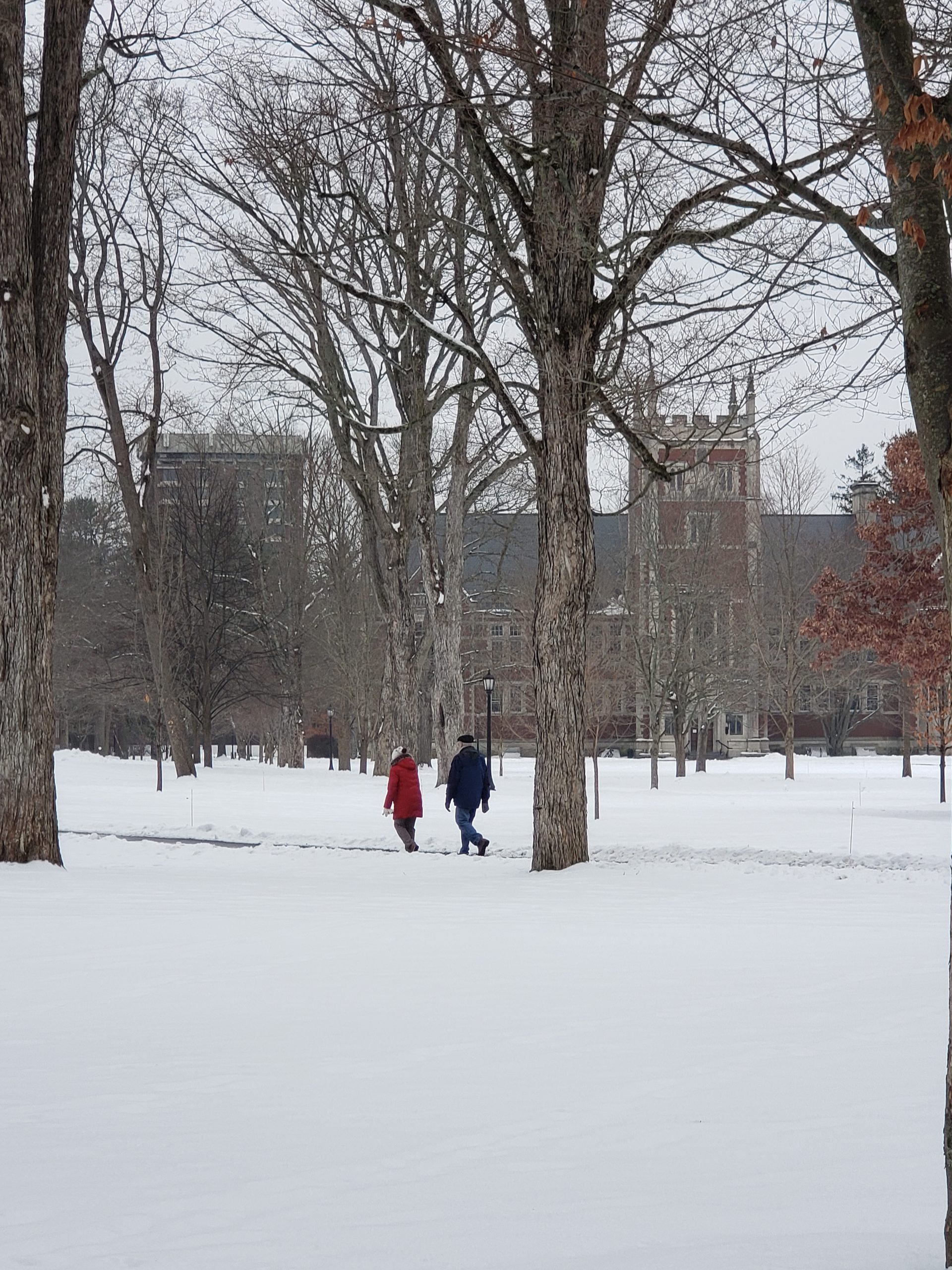 How many aspects of life at Bowdoin College have remained unchanged since the days when faculty, president, and students all lived in Mass Hall? In January 2022, we can still fervently empathize with this account of the “spring” semester in the Journal of John Deering, Jr., class of 1864:
How many aspects of life at Bowdoin College have remained unchanged since the days when faculty, president, and students all lived in Mass Hall? In January 2022, we can still fervently empathize with this account of the “spring” semester in the Journal of John Deering, Jr., class of 1864:
Bowdoin College, Jan, 29, 1861.- “Find myself back to this honored institution after an absence of nine weeks… Nothing can be seen except a boundless expanse of snow, variegated by little cow paths just wide enough to allow one to walk in them with imminent danger of being precipitated into the snow banks. The students looked “blue” enough also, and I don’t blame them, for the whole prospect is disheartening enough… But after all, I suppose I can pursue my studies and carry out the objects for which I was sent just as well as if the grass were green and the birds singing.”
(John Deering Jr. enlisted in the 13th Maine regiment of the Union Army in December 1861. Like many Bowdoin students, he later became a lawyer, and practiced in Washington, DC.)
Why Attend a Small College in Maine?
According to the Bowdoin History of the Class of 1876: 
“Small colleges have some drawbacks, but they have also many advantages over the large colleges, and especially those in or near large cities. In the first place, the classes are smaller and the students have the personal care and interest of the professors themselves from the beginning of the Freshman year, instead of having a large part of their instruction from tutors. The professors become acquainted with each member and learn to appreciate his weak and strong points, and have more direct influence over him, and the student feels more free to go to the professor for instruction or advice: and, again, the smaller size of the class makes it possible for all to become acquainted, and develops a stronger feeling of attachment; and the strengthening of all such finer emotions is a desirable thing.
Another thing to be considered, in regard to a small country college like Bowdoin, is its comparative isolation from the attractions and temptations of a large city. It is not claimed that the students of Bowdoin were models of moral rectitude… but it is claimed that those who were not so inclined had less temptation placed in their way and those who were so inclined had less opportunity for the free indulgence of their tastes.”
“Brunswick was a pretty little town of about five thousand inhabitants, with streets shaded by rows of stately elms. It was not large enough to afford much excitement; the students generally found more of interest within the college, and yet they were not so much deprived of society as those in a very small town like Hanover, N. H.”
The Well on the Quad
“Some of our class at times expressed the opinion that it would be a great improvement if a system of water works could be introduced and the buildings piped, so that the students need not have to go out to the well in stormy weather for a pail of water; and if gas could be introduced, so they need not be obliged to have the care of lamps; and if a modern system of heating could be put in, so they might be relieved of the care and work of heating their own rooms.
But if they had been supplied with these luxuries they might also have wished the college to provide a place in the grounds for meals instead of being obliged to walk down town… Had they had all of these comforts and conveniences, they would only have wanted more, and would have become so enervated that they would have disliked to do the slightest work themselves. It does seem funny, when we look back, to think of a fellow lugging a heavy pail of water up to his room on the fourth floor and immediately emptying it out of the window on some luckless Freshman.”
In 1876, tuition, rent and incidentals cost around $230. Homework Assignment: was Bowdoin more or less expensive in 1876 than today? (For helpful hints, see Measuring Worth.)
Orientation 
Bowdoin Orient(ation), 1876: “A new class is with us ; new faces meet us in the chapel, on the walks, and in the dormitories, around which cluster the memories and associations of former occupants… Remember that the credit and reputation of the college are largely in the keeping of its undergraduates…”
The Orient newspaper of 1876 was alert to all the important breaking news:
“An hour of quiet meditation the other evening before the glowing grate, while the snow whirled against the window-panes and the wind moaned dismally without…
We fear the College Art Gallery is not fully appreciated by the great body of undergraduates. Very few seem aware of the treasures it contains or of the advantages it affords…
Members of the University Crew say that a pair of oars have mysteriously disappeared from the boat-house. The thief will find it a difficult matter to conceal them on his person.
The melting snow under the Hall windows is disclosing its secrets. [Perhaps, a pair of oars?]
One of the dwellers in the South End of Appleton seems to have no ear for music…. Some fine horn playing can be heard in the north end of Appleton. [Still true]
The Sophomores are having lectures on Mathematics. A beautiful study, and we who are old and have died, wish you well.

Recitation in Political Economy. President: “Mr. B., how far do you agree with the statement of Dr. Walker that ‘labor is always irksome ‘?” Mr. B.—”I agree with him fully.”
The political majority in this College seems to be decidedly Republican. [?!!!]
The reminiscences of the College life of one who entered Bowdoin just sixty years ago this summer, show that although many customs have changed, there is yet much in common between the Bowdoin of 1816 and the Bowdoin of 1876.”
“The student could lie in his room with his window open and be lulled to sleep by the whispering of the pines in the woods which partly bounded the college grounds; for, as the Peucinians were wont to say, “Pinos Loquentes Semper Habemus.”” In short, regardless of the multitude of changes between 1794 and 2022: we will always have the whispering pines.
